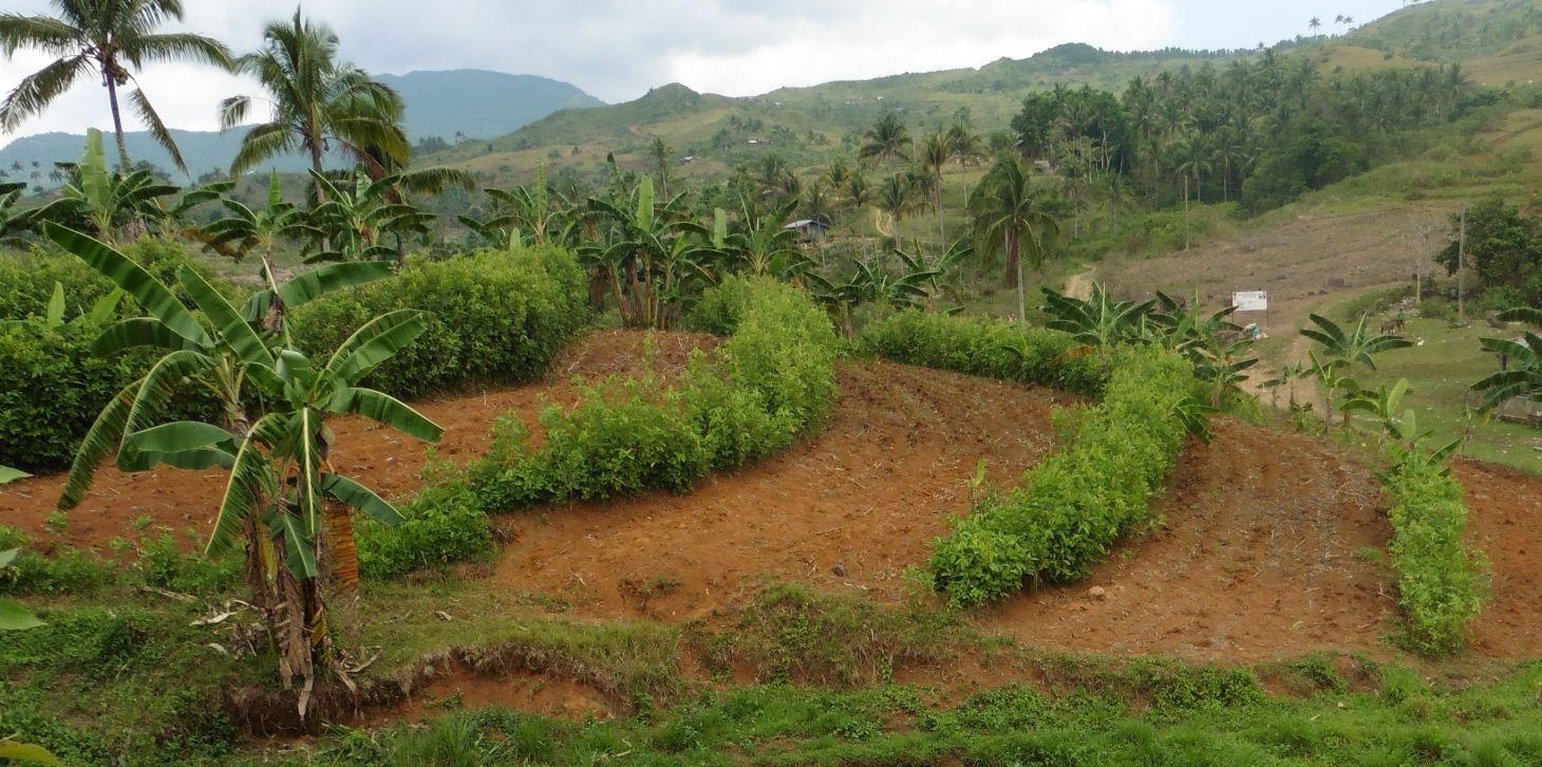Conservation Farming Village
(Philippines)
Description
A modality in mobilizing resources for sustainable upland development which utilizes a basket of strategies, technologies, and interventions to catalyze the widespread transformation of traditional upland farming systems into resilient and sustainable upland production systems.
The objectives of Conservation Farming Village (CFV) are the following: to enhance farmers' adoption of sloping land management technologies through Science and Technology-based farming; to capacitate key groups and stakeholders in the community to better manage fragile upland resources; to conduct sustainability exercises to ensure sustainability of upland community development; to establish linkages among research-extension agencies and organizations for capacity building; and to provide support systems for the conservation farming communities.
The methods involved in the approach include capacitating upland farmers for sustainable development; strong Local Government Unit (LGU) support system; and establishing collaborative linkages and partnership as a tool for an enhanced support system.
The project of CFV in La Libertad, Negros Oriental was initiated in 2009. The first stage in the implementation of the approach is program orientation followed by community profiling. Then, Community Organizing or People's Organization strengthening. After that, technical trainings, barangay development council and municipal development council meetings were conducted to capacitate the farmers. Farm establishment was done through 'bayanihan' or group volunteerism, and lastly, farmers were encouraged to participate in the CFV.
The National Program Coordinating Office, Philippine Council for Agriculture, Aquatic and Natural Resources Research and Development (PCAARRD) and academic institutions (University of the Philippines Los Baños, Silliman University) provided technical support in the conceptualization and implementation of CFV. The LGU of La Libertad conducted the following : (1) capacity building for farmer volunteers and adopters; (2) assist in the establishment of science and technology-based conservation model farms; (3) incorporate CFV activities in the LGU Annual Investment Plan; and (4) provision of livelihood and support mechanisms to farmers.The implementation of the CFV project became a focal point of convergence of relevant and related activities being undertaken in the upland communities of La Libertad by Non-Government Organizations (NGOs), Government Offices (GOs) and other institutions.Through this approach, the farmers have made linkage with other service providers that enhanced the farmers' access to examine other technology options, livelihood opportunities, credit and financing source, and others that may help the farmers.
Location
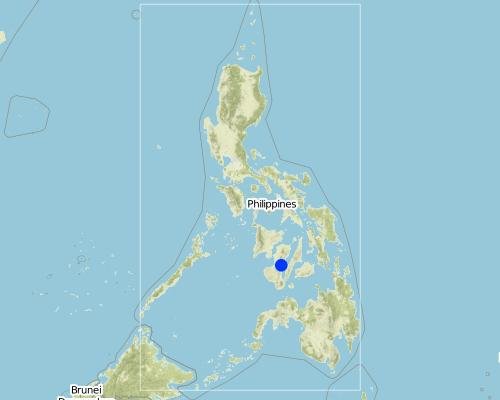
Location: La Libertad, Negros Oriental, Philippines
Geo-reference of selected sites
Initiation date: 2009
Year of termination: n.a.
Type of Approach
-
traditional/ indigenous
-
recent local initiative/ innovative
-
project/ programme based
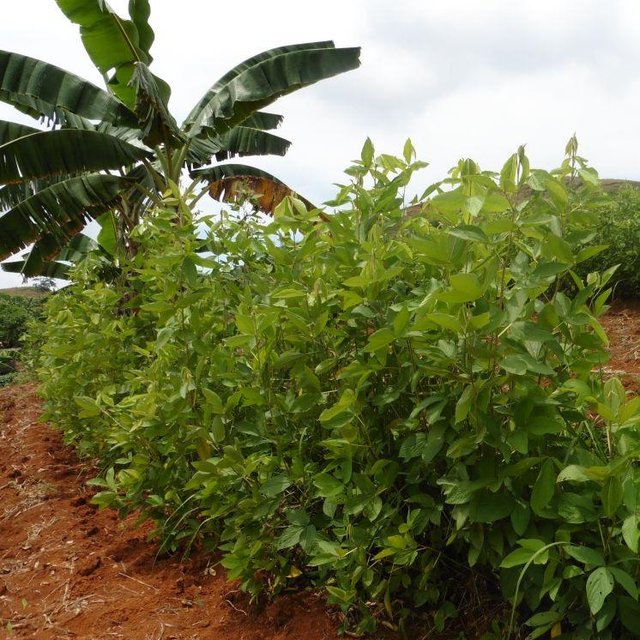
Flemengia and banana planted as hedgerows. (Engr. Djolly Ma. P. Dinamling, Bureau of Soils and Water Management)
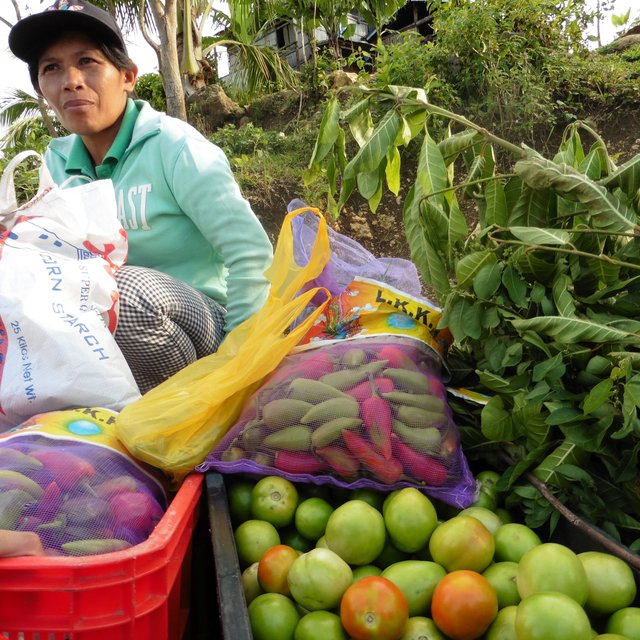
An upland farmer of CFV delivering the harvested crops in the market (Engr. Djolly Ma. P. Dinamling (Bureau of Soils and Water Management))
Approach aims and enabling environment
Main aims / objectives of the approach
The CFV addresses the development, application, and validation of integrated farming systems in which holistic technology transfer and emphasis on sustainable development dimensions - environmental, economic, social - are the major driving forces for economic and environmental security.
Conditions enabling the implementation of the Technology/ ies applied under the Approach
-
Social/ cultural/ religious norms and values: Selection of farmer volunteers to be included in the CFV program and establishment of model farms. Government executives were invited to participate in farmers' field day in remote upland villages to show to the farmers their intention to support the program.
-
Availability/ access to financial resources and services: Incorporation of the CFV program in the Annual Investment Plan (AIP) of the LGU of La Libertad, Negros Oriental
-
Institutional setting: Farmers' organizations were organized and strengthened by mobilizing the 'Dagyaw Team' or Volunteers Group for the establishment of CFV model farms.
-
Knowledge about SLM, access to technical support: Provided series of technical training on the concepts and practices in CFV to the Barangay Development Councils (BDCs), Farmer Association, Municipal Development Councils (MDCs) and other stakeholders to enhance awareness on land degradation in the uplands and other environmental issues.
Conditions hindering the implementation of the Technology/ ies applied under the Approach
Participation and roles of stakeholders involved
Stakeholders involved in the Approach and their roles
| What stakeholders / implementing bodies were involved in the Approach? |
Specify stakeholders |
Describe roles of stakeholders |
| local land users/ local communities |
Land user from the upland barangay |
|
| SLM specialists/ agricultural advisers |
LGU of La Libertad |
|
Lead agency
Local land users
Involvement of local land users/ local communities in the different phases of the Approach
none
passive
external support
interactive
self-mobilization
initiation/ motivation
Ten model farms were selected from CFV barangays.
planning
Participation in meetings, sharing inputs.
implementation
Model farm establishment and maintenance, Farmer volunteers serve as local extension agents to fellow farmers.
monitoring/ evaluation
Participation in consultation meetings, farm record keeping.
Flow chart
Organizational structure in the implementation of CFV
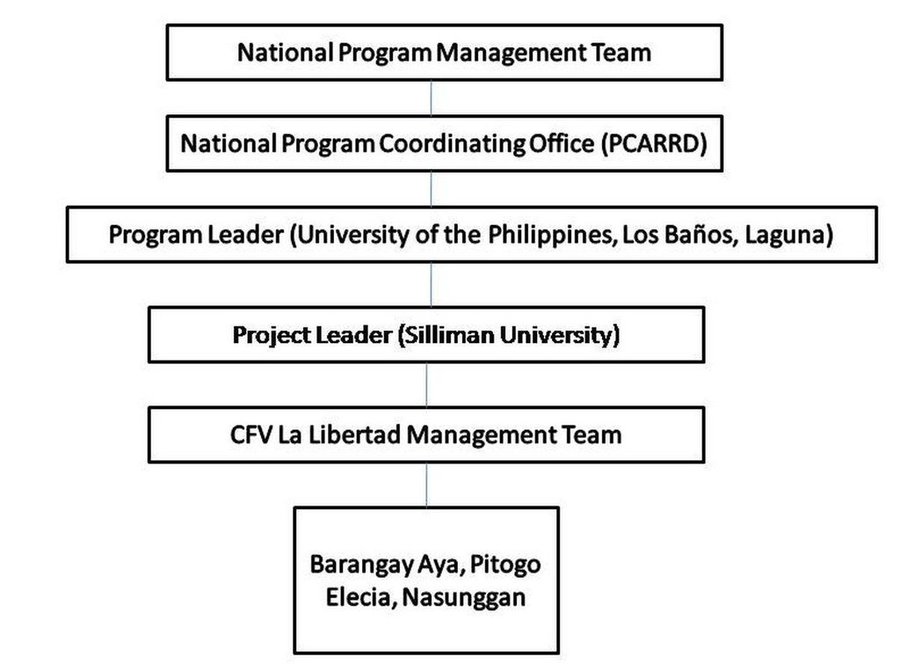
Author: Dr. Rex Victor O. Cruz, University of the Philippines, Los Baños
Decision-making on the selection of SLM Technology
Decisions were taken by
-
land users alone (self-initiative)
-
mainly land users, supported by SLM specialists
-
all relevant actors, as part of a participatory approach
-
mainly SLM specialists, following consultation with land users
-
SLM specialists alone
-
politicians/ leaders
Decisions were made based on
-
evaluation of well-documented SLM knowledge (evidence-based decision-making)
-
research findings
-
personal experience and opinions (undocumented)
Technical support, capacity building, and knowledge management
The following activities or services have been part of the approach
-
Capacity building/ training
-
Advisory service
-
Institution strengthening (organizational development)
-
Monitoring and evaluation
-
Research
Capacity building/ training
Training was provided to the following stakeholders
-
land users
-
field staff/ advisers
Form of training
-
on-the-job
-
farmer-to-farmer
-
demonstration areas
-
public meetings
-
courses
Subjects covered
Conservation Farming, Sloping Land Management, Agroforestry, Climate Change , Organic Farming/Fertilizer Production, measuring rainfall and soil erosion. Trainers' training were conducted to capacitate the implementer.
Institution strengthening
Institutions have been strengthened / established
-
no
-
yes, a little
-
yes, moderately
-
yes, greatly
Describe institution, roles and responsibilities, members, etc.
Type of support
-
financial
-
capacity building/ training
-
equipment
Further details
Monitoring and evaluation
Research
Research treated the following topics
-
sociology
-
economics / marketing
-
ecology
-
technology
Researches were conducted by PCAARRD and UPLB to evaluate the approach and technologies introduced in the area. Land users were also taught about climatic data collection such as rainfall and farm record keeping that could be used in evaluating the impacts.
Financing and external material support
Annual budget in USD for the SLM component
-
< 2,000
-
2,000-10,000
-
10,000-100,000
-
100,000-1,000,000
-
> 1,000,000
Precise annual budget: n.a.
PCAARRD and UPLB 30%, LGU of La Libertad 70%
The following services or incentives have been provided to land users
-
Financial/ material support provided to land users
-
Subsidies for specific inputs
-
Credit
-
Other incentives or instruments
Financial/ material support provided to land users
partly financed
fully financed
equipment: tools
shovel, mattock, sickle and bolo
agricultural: seeds
vegetable & forage seeds, coffee & cacao seedlings
Labour by land users was
-
voluntary
-
food-for-work
-
paid in cash
-
rewarded with other material support
Impact analysis and concluding statements
Impacts of the Approach
No
Yes, little
Yes, moderately
Yes, greatly
Did the Approach help land users to implement and maintain SLM Technologies?
Soil and water conservation measures were introduced to the land users such as contour hedgerows of legumes that contribute in improving the quality of the soil and lessen soil erosion.
Did the Approach empower socially and economically disadvantaged groups?
The approach involved the upland farmers in the establishment of science and technology based farms. 80-90% of the farmer-volunteers and adaptors perceived that CFV led to an increase in their crop and farm yield resulting in increased income.
Did the Approach improve issues of land tenure/ user rights that hindered implementation of SLM Technologies?
Did the Approach lead to improved food security/ improved nutrition?
Increase in per capita income of CFV farmer-volunteers from Php 7,973.00 in 2004 to Php 16,745.42 in 2013, representing 47.6% increase.
Did other land users / projects adopt the Approach?
Eight barangays with fifteen model farms adopted the CFV approach in La Libertad, Negros Oriental. The program was also replicated by other neighboring municipality.
Main motivation of land users to implement SLM
-
increased production
-
increased profit(ability), improved cost-benefit-ratio
-
reduced land degradation
-
reduced risk of disasters
-
reduced workload
-
payments/ subsidies
-
rules and regulations (fines)/ enforcement
-
prestige, social pressure/ social cohesion
-
affiliation to movement/ project/ group/ networks
-
environmental consciousness
-
customs and beliefs, morals
-
enhanced SLM knowledge and skills
-
aesthetic improvement
-
conflict mitigation
-
Trainings and study tours (Lakbay-Aral)
Sustainability of Approach activities
Can the land users sustain what hat been implemented through the Approach (without external support)?
The land users were capacitated by the LGU through trainings, cross visits so that they can manage their farms and to share the knowledge with neighboring farmers.
Conclusions and lessons learnt
Strengths: land user's view
-
Marketing support system with the establishment of barangay trading post in the CFV sites,support for the operations of the two livestock auction markets at two barangays, transport of farm products from CFV sites to Poblacion in time for the market day every Thursday and linkage with OURFOOD Program (AFOS) based in Cebu City for the marketing of organically-grown high value crops.
Strengths: compiler’s or other key resource person’s view
-
Strong LGU support wherein they are the forefront for the present and the future of the CFV programs or any development program.They are the only permanent local institution that could deliver services and support to development initiatives.
Weaknesses/ disadvantages/ risks: land user's viewhow to overcome
Weaknesses/ disadvantages/ risks: compiler’s or other key resource person’s viewhow to overcome
-
No clear zoning and proper delineation for the CFV and reforestation areas.
There should be a clear zoning through policy and ordinance by the national and local government to sustain and preserve the CFV sites.
References
Compiler
-
Philippine Overview of Conservation Approaches and Technologies
Date of documentation: Maart 20, 2017
Last update: April 5, 2017
Resource persons
-
Philippine Overview of Conservation Approaches and Technologies (philcatsecretariat@gmail.com) - SLM specialist
-
Dr. Rex Victor O. Cruz (rexcruz@yahoo.com) - SLM specialist
Full description in the WOCAT database
Documentation was faciliated by
Institution
- Department of Agriculture-Region VIII (DA-8) - Philippines
- Farming Systems and Soil Resources Institute, University of the Philippines Los (Farming Systems and Soil Resources Institute, University of the Philippines Los) - Philippines
- Municipality of La Libertad, Negros Oriental, Philippines (Municipality of La Libertad) - Philippines
- Silliman University, Dumaguete, Philippines (Silliman University) - Philippines
Project
- Decision Support for Mainstreaming and Scaling out Sustainable Land Management (GEF-FAO / DS-SLM)
